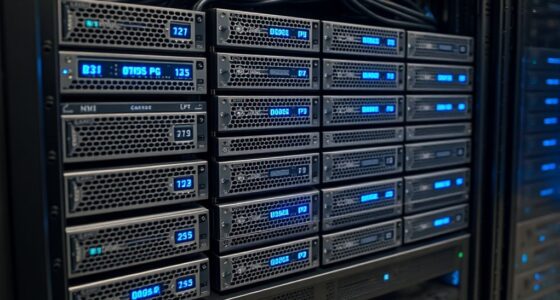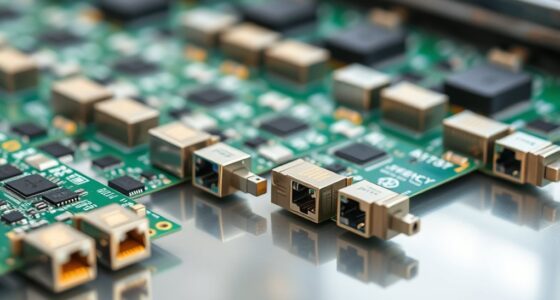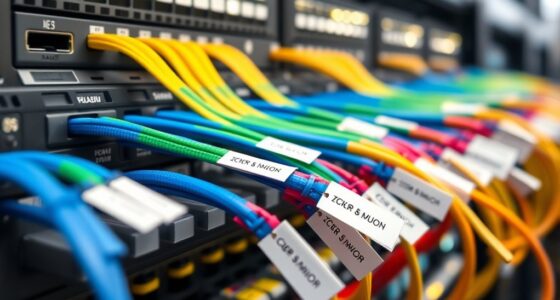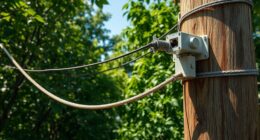If you’re looking for the 15 best DWDM fiber optic multiplexers of 2025 for high-speed data transfer, I can help. These top devices offer reliable, scalable solutions with support for multiple wavelengths, high bandwidth, and low signal loss—ideal for expanding networks. From cost-effective models to advanced multiplexers with redundancy, you’ll find options suited for telecom and enterprise needs. Keep exploring, and you’ll discover detailed insights to make the perfect choice for your network.
Key Takeaways
- Top DWDM multiplexers in 2025 offer high spectral accuracy and multiple wavelength support for optimal high-speed data transmission.
- They feature industry-standard compliance, ensuring seamless integration with existing fiber optic networks.
- Advanced models include redundancy, remote management, and flexible wavelength configurations for network resilience.
- Key considerations include channel spacing, spectral width, and compatibility with transceivers for reliable performance.
- The best multiplexers cater to various network scales, from telecom providers to enterprise data centers, prioritizing scalability and reliability.
Lc Gigabit Fiber Media Converter Wdm Multiplexer Optical Module
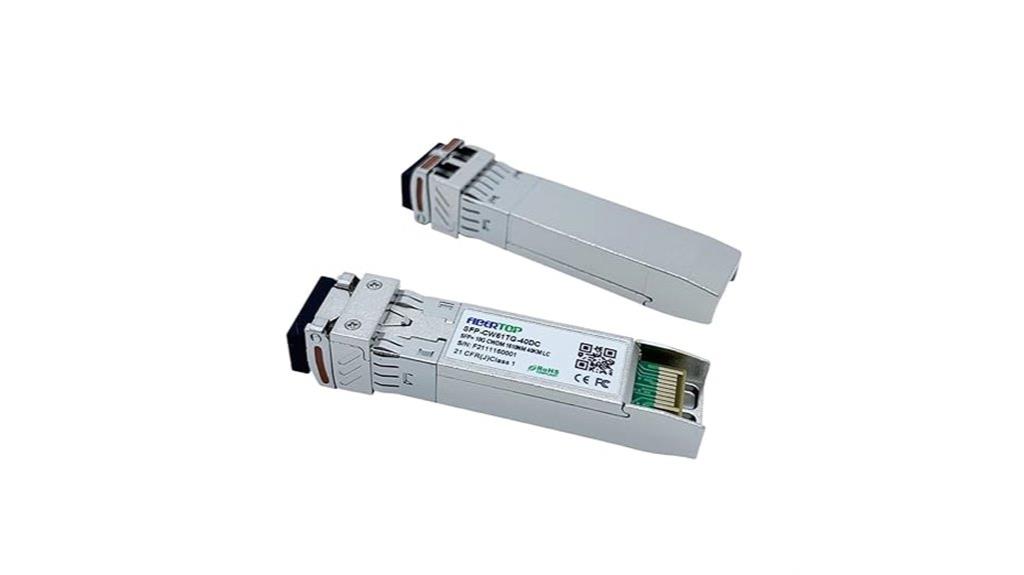
If you’re looking for a reliable solution to boost your fiber optic network’s capacity, the LC Gigabit Fiber Media Converter WDM Multiplexer Optical Module is an excellent choice. It efficiently combines multiple signals over a single fiber using WDM technology, maximizing bandwidth. Acting as a fiber optic transmitter, it converts electrical signals into optical ones for high-speed transmission. Supporting gigabit data rates ensures fast, seamless data flow. Its compatibility with LC connectors allows easy integration into existing infrastructure. Perfect for telecommunications, data centers, and enterprise networks, this module enhances network performance while maintaining simplicity and reliability in fiber optic communication.
Best For: organizations and professionals in telecommunications, data centers, and enterprise networks seeking high-speed, reliable fiber optic transmission solutions using WDM technology.
Pros:
- Supports gigabit data rates for fast, seamless transmission
- Utilizes WDM technology to maximize bandwidth efficiency
- Compatible with LC connectors for easy integration
Cons:
- May require technical expertise for installation and configuration
- Limited to fiber optic environments, not suitable for copper networks
- Potentially higher cost compared to non-WDM modules
PNGKNYOCN 6 Core FTTH Fiber Distribution Box

The PNGKNYOCN 6 Core FTTH Fiber Distribution Box is an ideal choice for network installers seeking a reliable, compact solution for managing optical fiber connections. Its wall-mounted design and small size—180 * 110 * 40mm—make it versatile for various environments, including indoor, wall, or hanging installations. It features six ports for FTTH cables, supporting fusion splicing, splitting, and signal management. Made from durable, waterproof materials, it guarantees long-lasting performance and safety. The box is easy to install with minimal technical expertise, compatible with multiple adapters like SC, FC, and E2000, providing flexible, efficient fiber optic connections.
Best For: network installers and technicians seeking a reliable, compact, and easy-to-install fiber distribution solution for various environments.
Pros:
- Compact and wall-mounted design for versatile installation options
- Durable, waterproof, and impact-resistant materials ensure long-term reliability
- Compatible with multiple adapters (SC, FC, E2000) for flexible fiber optic connections
Cons:
- Limited to 6 ports, which may not suit large-scale or high-capacity networks
- Requires basic technical knowledge for installation and setup
- May need additional accessories for complex network configurations
Lc Gigabit Fiber Media Converter Wdm Multiplexer Optical Module
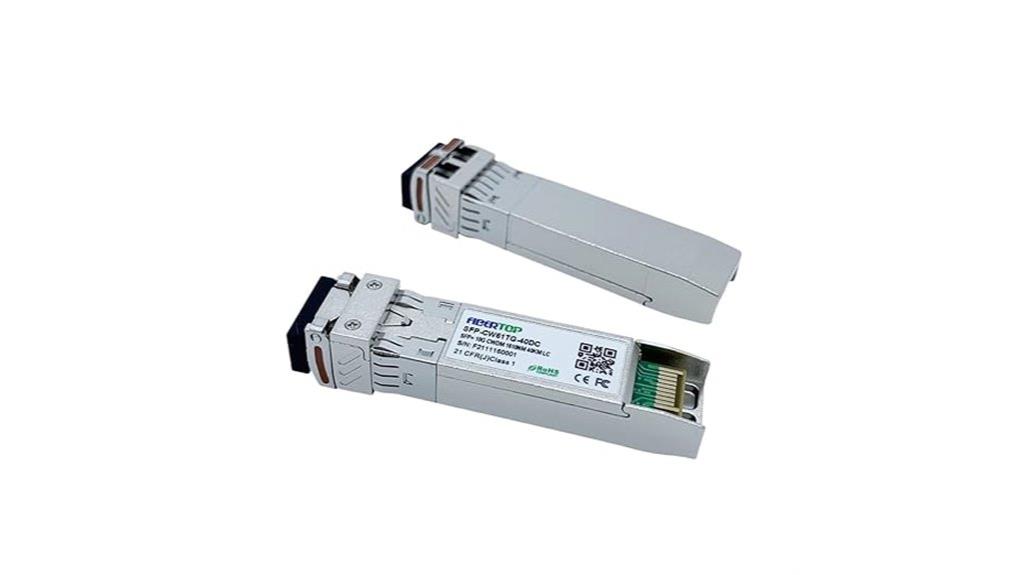
For network professionals seeking reliable high-speed fiber connectivity, the Lc Gigabit Fiber Media Converter Wdm Multiplexer Optical Module offers an efficient solution by seamlessly enabling gigabit data transmission over long distances. This optical module facilitates fiber media conversion and employs wavelength division multiplexing (WDM) to maximize bandwidth. It’s designed for high-capacity, long-distance communication, making it ideal for expanding networks or upgrading infrastructure. With built-in fiber optic attenuators, it effectively manages signal strength, ensuring ideal performance. Compatible with various fiber optic components, this module emphasizes reliability and efficiency, providing a solid foundation for high-speed, scalable fiber optic networks.
Best For: network professionals and data center operators seeking reliable, high-speed fiber optic solutions for long-distance and high-capacity network expansion.
Pros:
- Supports gigabit fiber media conversion and WDM for efficient bandwidth utilization
- Includes fiber optic attenuators to optimize signal strength and reliability
- Compatible with various fiber optic components, ensuring flexible deployment
Cons:
- May require specialized knowledge for installation and configuration
- Potentially higher cost compared to simpler, non-WDM modules
- Limited to high-capacity, long-distance applications, less suitable for small or short-range networks
Tripp Lite Duplex Singlemode 9/125 Fiber Patch Cable (10 Pack)
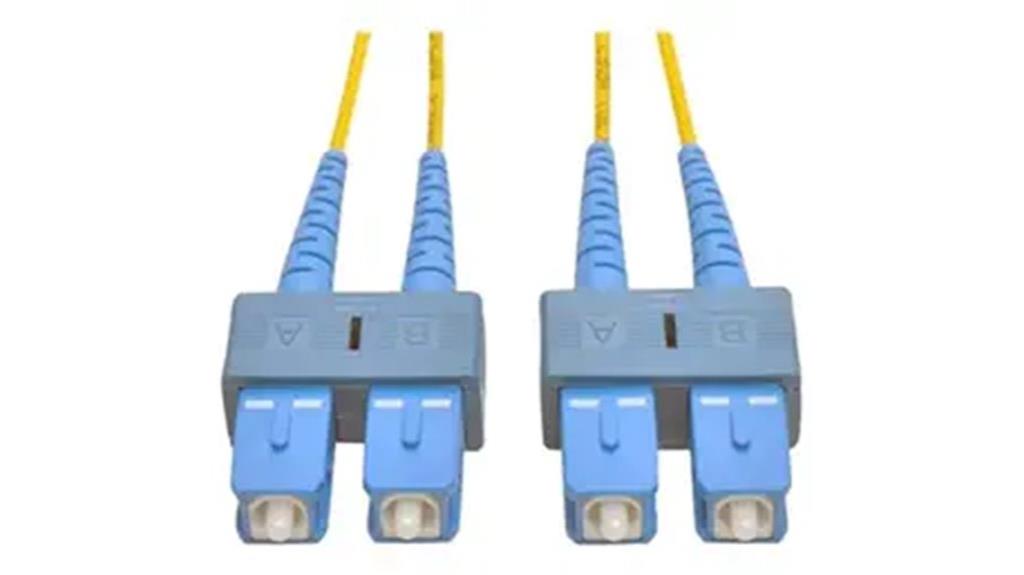
When selecting reliable fiber optic cables for high-speed data transfer, the Tripp Lite Duplex Singlemode 9/125 Fiber Patch Cable (10 Pack) stands out as an excellent choice for data center managers and network engineers. These cables deliver ultra-low loss connectivity ideal for high-speed applications like 10G, 40G, and 100G, supporting seamless upgrades and long-range transmission. With precision-polished SC/SC connectors and a durable flame-resistant PVC jacket, they guarantee maximum signal integrity and durability in demanding environments. The 2-meter length simplifies rack management and minimizes signal loss, making them perfect for switch-to-patch panel, media converter, or wall outlet connections in complex networks.
Best For: data center managers and network engineers seeking reliable, high-speed fiber optic connections for enterprise, telecom, or broadcast systems.
Pros:
- Ultra-low loss connectivity supporting high-speed applications like 10G, 40G, and 100G
- Durable, flame-resistant PVC jacket resistant to bends, crush, and abrasion
- Precise-polished SC/SC connectors ensuring optimal signal integrity and minimal back reflection
Cons:
- Only available in 2-meter lengths, which may require additional cables for larger setups
- Sold as a pack of ten, which might be excessive for small-scale deployments
- Compatibility limited to specific transceiver types; may require matching equipment
YICIZOL 30km Visual Fault Locator and FTTH Tool Kit
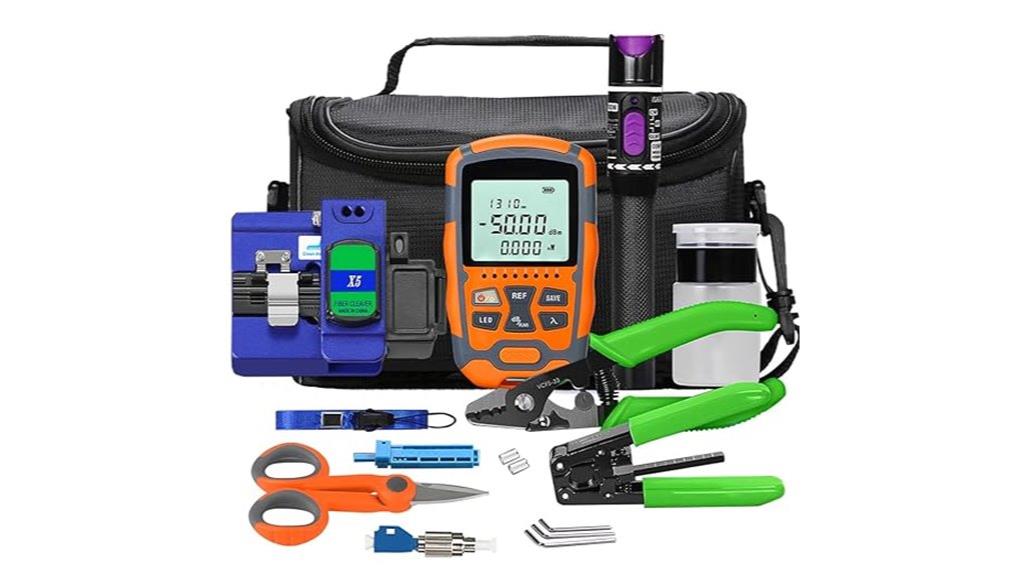
If you’re working on fiber optic installations or maintenance, the YICIZOL 30km Visual Fault Locator and FTTH Tool Kit stands out with its extensive testing capabilities. It combines an optical power meter that measures seven wavelengths, from 850 to 1650nm, with a testing range of -70dBm to +6dBm, and supports features like lighting, auto shutdown, and wavelength memory. The visual fault locator detects fiber breaks, poor connections, and bends, compatible with various connectors and cable types. The kit also includes a fiber cleaver for precision splicing, making it a all-encompassing tool for FTTH, CATV, and other fiber optic projects.
Best For: technicians and engineers performing fiber optic installations, maintenance, and troubleshooting in FTTH, CATV, and related projects.
Pros:
- Combines multiple essential tools (power meter, fault locator, fiber cleaver) into one comprehensive kit.
- Supports a wide range of wavelengths and connector types for versatile testing.
- Easy to use with features like auto shutdown, backlight, and universal connectors, enhancing efficiency.
Cons:
- The device may require calibration and familiarity to maximize accuracy.
- Limited to a testing range of -70dBm to +6dBm, which might not cover extremely high or low power levels.
- The kit’s size and weight could be less portable for fieldwork over long distances.
Low Cost 4 T1/E1 PDH Fiber Optic Multiplexer
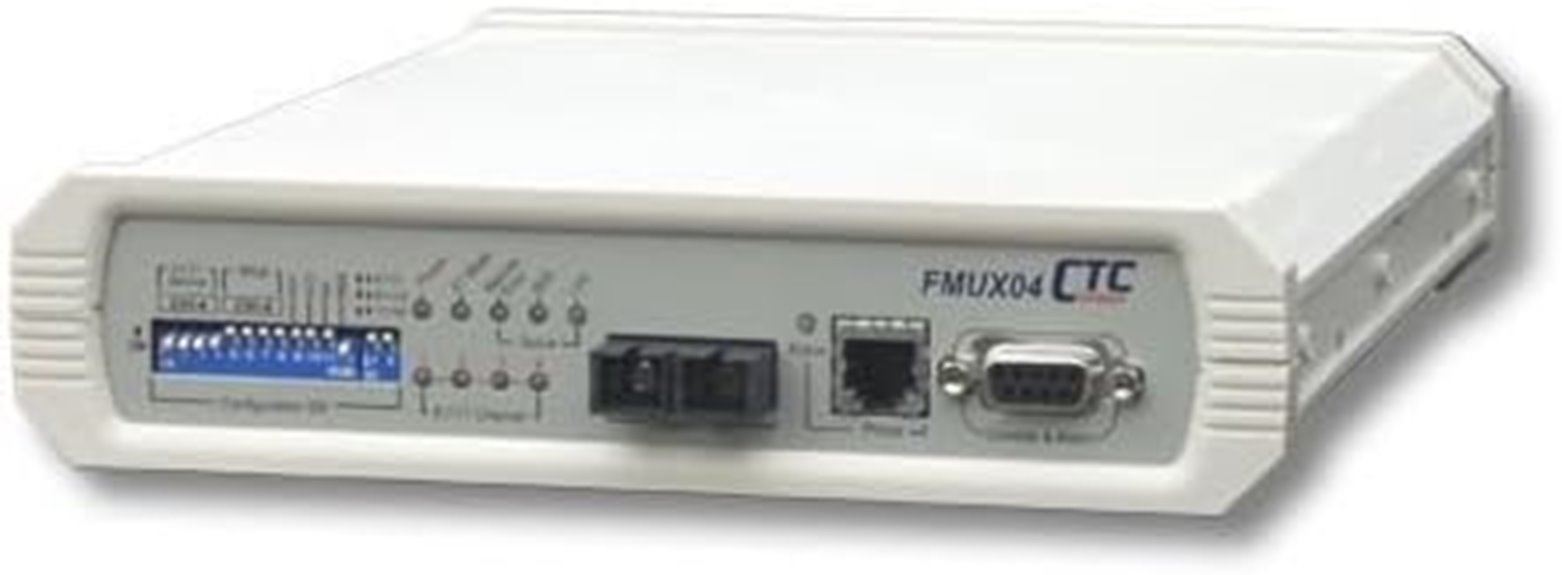
The Low Cost 4 T1/E1 PDH Fiber Optic Multiplexer stands out as an ideal choice for small-scale telecommunications providers seeking an affordable yet reliable solution. It offers multi-mode 1310nm fiber with SC connectors and a 2 km reach, perfect for expanding mobile networks or building coverage in remote areas. Its fixed configuration supports four T1 or E1 interfaces, with SNMP management and remote loop-back capabilities. Compact and lightweight, it can be easily installed on desktops or in rack mounts. Designed for cost-conscious applications, this multiplexer guarantees stable performance with low BER and flexible fiber options, making it a practical choice for budget-sensitive telecom deployments.
Best For: small-scale telecom providers and mobile network expanders seeking an affordable, reliable fiber optic multiplexer for remote coverage and channel extension.
Pros:
- Cost-effective solution suitable for budget-conscious deployments
- Supports multi-mode fiber with a 2 km reach for remote connectivity
- Easy to install and manage with SNMP, remote loop-back, and front panel controls
Cons:
- Fixed configuration limits flexibility to four T1/E1 interfaces only
- Limited to multi-mode fiber options, not compatible with single-mode fibers for longer distances
- May lack advanced features needed for larger or more complex telecom networks
VFLTOOL 4 Pack Fiber Patch Panel Enclosure
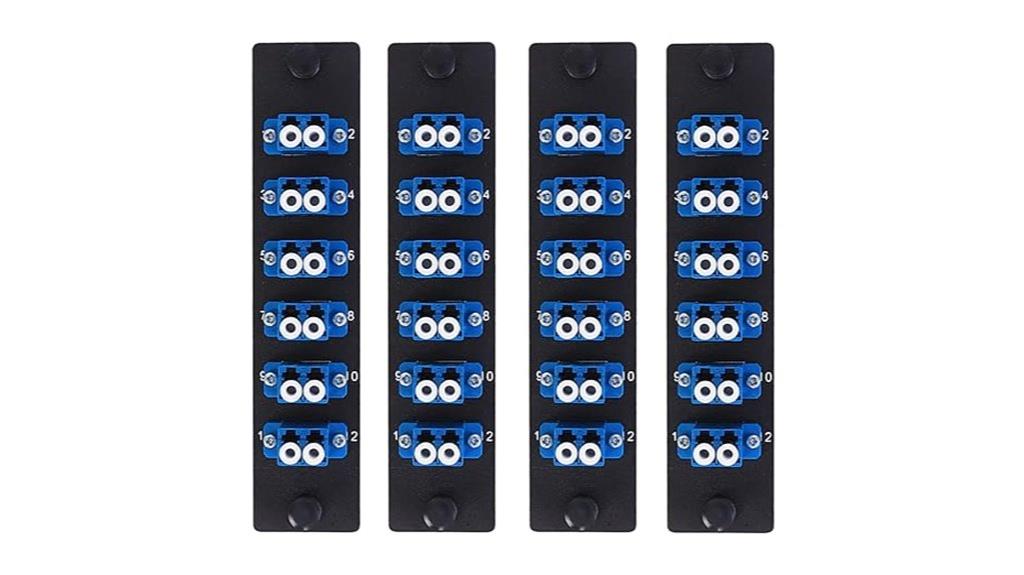
The VFLTOOL 4 Pack Fiber Patch Panel Enclosure stands out as an excellent choice for network engineers seeking a durable, high-performance solution to organize and manage fiber optic connections. Its robust steel construction with a corrosion-resistant powder coating guarantees longevity in demanding environments. Featuring 6 duplex LC adapters and 12 fiber ports, it supports both single and multimode fibers, making it versatile for various high-speed networks like Ethernet and Fiber Channel. The plug-and-play, snap-in design allows for quick, tool-free installation, optimizing rack space and simplifying maintenance. Overall, it’s a reliable, efficient option for data centers, LANs, and enterprise networks.
Best For: network engineers and IT professionals seeking a durable, high-performance fiber patch panel enclosure for organizing and managing fiber optic connections in data centers, LANs, and enterprise networks.
Pros:
- Durable steel construction with corrosion-resistant powder coating for long-term reliability
- Supports both single and multimode fibers with 6 duplex LC adapters and 12 fiber ports
- Tool-less, snap-in design allows quick installation and easy maintenance
Cons:
- May be heavier than plastic alternatives, potentially affecting portability
- Fixed number of ports limits scalability for expanding networks
- Compatibility with only specific fiber types and standards may restrict use in certain setups
1 Pair 8 Channel Fiber Optic Voice Tel Extender with Ethernet

For communication providers seeking a reliable solution to extend voice and data transmission over fiber optic networks, the Pair 8 Channel Fiber Optic Voice Tel Extender with Ethernet stands out. Its modular design ensures stable, high-performance operation, supporting 8-channel PCM voice and fax functions. It offers a 100M Ethernet routing speed, making it suitable for demanding environments. The rack-mountable chassis in 2U or 4U sizes, combined with centralized power management, simplifies installation and maintenance. Designed for major operators, government agencies, and enterprises, it guarantees high stability and seamless integration with existing infrastructure, enabling long-distance fiber optic multiplexing for both voice and data.
Best For: communication providers, government agencies, and enterprises seeking a stable, high-capacity solution for extending voice and data transmission over fiber optic networks.
Pros:
- Modular design ensures high stability and reliable performance
- Supports 8-channel PCM voice transmission, fax, and Ethernet routing at 100M speed
- Rack-mountable with centralized power management simplifies installation and maintenance
Cons:
- May require technical expertise for installation and configuration
- Larger chassis sizes (2U or 4U) could be less suitable for small-scale setups
- Compatibility depends on existing infrastructure, potentially necessitating additional integration efforts
SFP Ethernet Fiber Optic Switch with 4 Optical and 2 Electrical Ports

If you’re looking for a versatile switch that seamlessly combines fiber and Ethernet connectivity, the SFP Ethernet Fiber Optic Switch with 4 optical and 2 electrical ports is an excellent choice. It supports 1000m Ethernet fiber transceivers and features LED indicators for easy status monitoring. The switch complies with IEEE standards and offers multicast, QoS, and full/half duplex modes, along with 9k jumbo frames for efficient data transfer. With support for hot-swappable SFP modules, it extends fiber communication up to 120km. Its rugged metal construction and plug-and-play setup make it ideal for industrial environments and long-range network applications.
Best For: professionals and industrial environments seeking a reliable, long-range fiber and Ethernet switching solution for high-performance network connectivity.
Pros:
- Supports up to 120 km fiber communication distance with hot-swappable SFP modules.
- Rugged metal construction suitable for industrial environments.
- Easy plug-and-play setup with LED indicators for real-time status monitoring.
Cons:
- Limited to 4 optical and 2 electrical ports, which may not suit larger networks.
- Requires compatible SFP modules for fiber transceivers, adding potential additional cost.
- No mention of advanced management features such as VLAN or network security options.
FMUX1600-AD Fiber Optic Multiplexer with Gigabit Ethernet

When selecting a high-performance fiber optic multiplexer, the FMUX1600-AD stands out with its Gigabit Ethernet connectivity and all-inclusive management features. It offers 16 E1/T1 interfaces and supports redundant fiber links with less than 50ms switchover, ensuring network resilience. The unit includes four Gigabit Ethernet ports, an RS-232 serial port, and an order wire interface, providing flexible data multiplexing options. Its management capabilities encompass local, remote, and web-based control, along with firmware upgrades. Powered by both AC and DC supplies, it’s designed for rack mounting, making it ideal for high-speed, reliable data transmission in demanding network environments.
Best For: telecom providers and enterprise networks requiring high-speed, resilient fiber optic multiplexing with comprehensive management and redundant link protection.
Pros:
- Supports 16 E1/T1 interfaces with flexible multiplexing options
- Features Gigabit Ethernet ports and serial interface for versatile connectivity
- Redundant fiber links with <50ms switchover ensure high network reliability
Cons:
- May require specialized technical knowledge for setup and management
- Physical size and rack-mount design could limit deployment in small spaces
- Higher initial cost compared to simpler multiplexers with fewer features
Toslink Digital Audio Splitter, 1×2 Fiber Optic Splitter
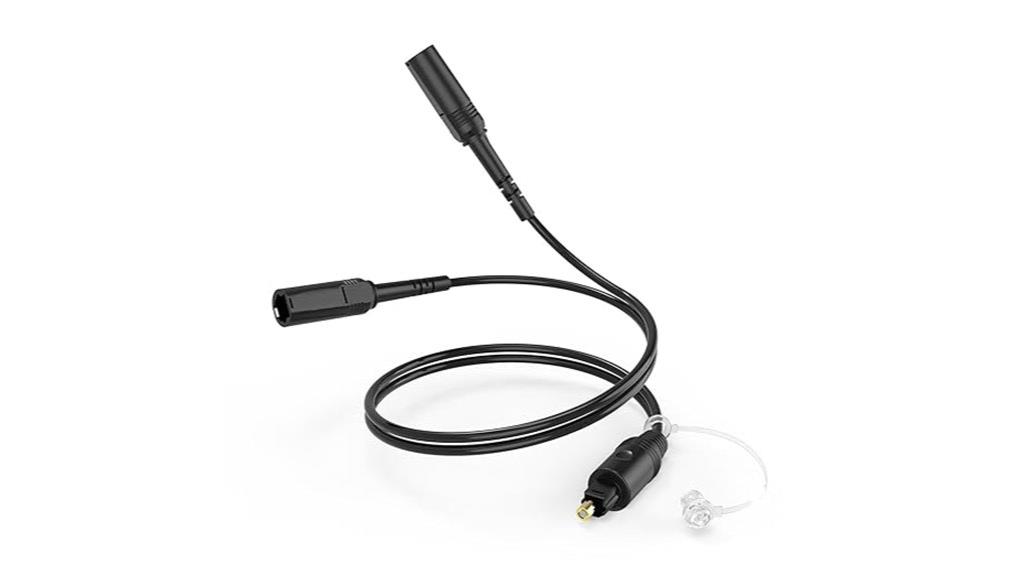
The Toslink Digital Audio Splitter, 1×2 Fiber Optic Splitter, stands out as an ideal choice for anyone seeking a reliable, dual-output solution to enhance their audio setup. It divides optical sound from your TV to connect simultaneously with a soundbar and headset, eliminating the hassle of cable switching. Supporting plug-and-play with devices like Blu-ray players, DVDs, HDTVs, PCs, and gaming consoles, it offers seamless compatibility. Crafted with corrosion-resistant gold-plated connectors and high-quality optical fiber, it ensures minimal signal loss over long distances. Users enjoy high-fidelity, immersive sound, and the ability to control volume independently for each output, making it perfect for gaming, movies, and music.
Best For: home entertainment enthusiasts and gamers seeking a reliable, dual-output optical audio splitter for seamless connection of soundbars, headsets, and multiple audio devices.
Pros:
- Supports uncompressed PCM, Dolby Digital Plus, and DTS-HD High Resolution for high-fidelity sound.
- Allows simultaneous connection of soundbar and headset with independent volume controls.
- Durable construction with corrosion-resistant gold-plated connectors and high-quality optical fiber ensures minimal signal loss over long distances.
Cons:
- Requires optical fiber cable, which can be delicate and needs careful handling during setup.
- May need additional adapters or transmitters for Bluetooth headphone compatibility.
- Limited to optical audio connections, so incompatible with non-TOSLINK devices without adapters.
100KM Fiber Optic Fault Locator with FC/ST/SC/LC Support
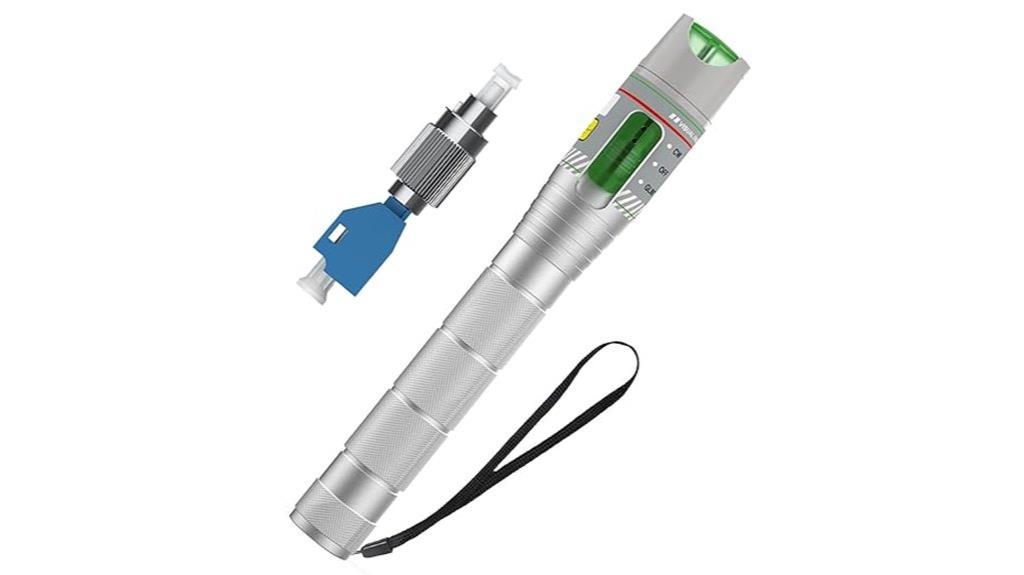
The KM Fiber Optic Fault Locator supports a wide range of connector types, including FC, ST, SC, and LC, making it an ideal choice for professionals who need versatile and reliable fault detection in complex fiber optic networks. It can pinpoint faults up to 100KM away by emitting visible light to identify breaks, bends, or poor connections quickly. Its stable pulse and continuous modes ensure consistent signals over long distances, while the durable aluminium body and stainless steel tip withstand tough field conditions. Lightweight and portable, it’s perfect for installation, maintenance, and troubleshooting in FTTH, telecom, data centers, and industrial environments, saving time and reducing downtime.
Best For: telecom engineers, fiber optic technicians, and infrastructure specialists needing reliable fault detection over long distances up to 100KM.
Pros:
- Supports multiple connector types (FC, ST, SC, LC) for versatile application
- Accurate fault pinpointing with visible light emission and stable modes up to 100KM
- Durable construction with aluminium alloy body and stainless steel tip suitable for harsh environments
Cons:
- Requires two AA batteries, which may need frequent replacement for extended use
- Limited to visual fault detection; cannot provide detailed loss measurements like an OTDR
- May be less suitable for users needing advanced diagnostic features beyond basic fault location
Optical Fiber Splitter 1 in 2 Out Toslink Audio Splitter

If you’re looking to split a single optical audio signal into two outputs effortlessly, the Optical Fiber Splitter 1 in 2 Out Toslink Audio Splitter is a practical choice. Made from durable ABS+PVC with gold-plated connectors, it guarantees stable, low-loss signal transmission and excellent sound quality. Its plug-and-play design makes setup simple—just remove the male plug cover and connect. It’s compact and lightweight, ideal for connecting A/V receivers, soundbars, headphones, gaming consoles, and more. Keep in mind, it only supports one input split into two outputs; check device compatibility beforehand for peak performance.
Best For: users seeking an easy, reliable solution to split a single optical audio signal into two outputs for home theater, gaming, or audio testing setups.
Pros:
- Stable, low-loss signal transmission with gold-plated connectors for excellent sound quality
- Plug-and-play setup requiring no additional software or equipment
- Compact, lightweight design easy to install and suitable for various audio devices
Cons:
- Supports only one input into two outputs; cannot function as a switch for multiple sources
- Variability in build quality; some units may have poor construction or non-standard ports
- Compatibility depends on device interface and signal strength, which may cause issues with weak or incompatible signals
Fiber Optic PLC Splitter for Optical Signal Transmission
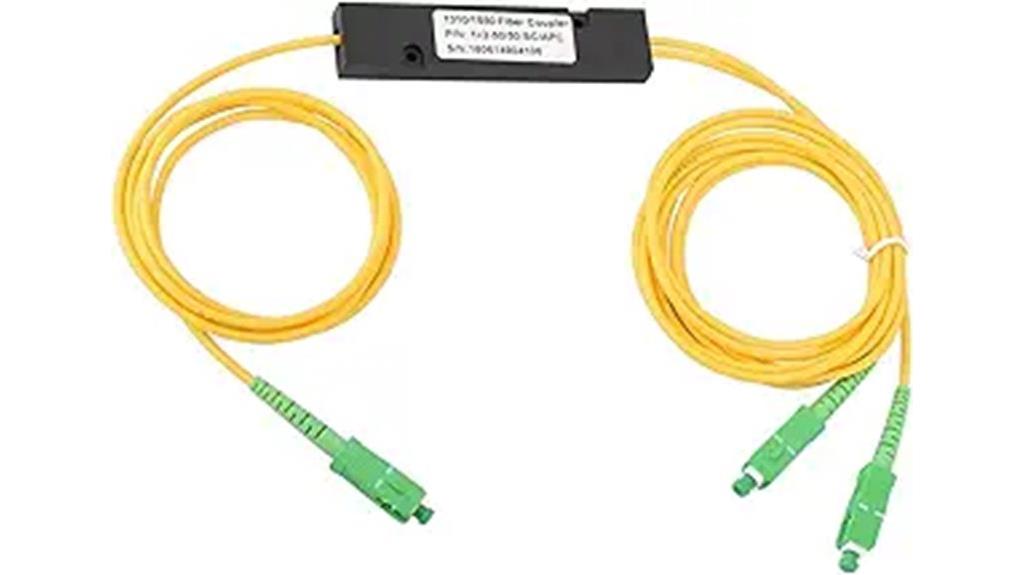
For professionals seeking reliable and efficient signal distribution in fiber optic networks, a Fiber Optic PLC Splitter is an ideal choice. It offers high-efficiency optical splitting and is insensitive to wavelength variations, making it suitable for diverse applications like FTTH, LANs, and CATV. Its compact, miniaturized design allows direct installation in junction boxes, saving space. Supporting over 32 channels per unit, it provides a cost-effective, high-capacity solution for network expansion. With low insertion loss—around 3.3 dB per port—and lightweight construction, it ensures reliable performance while simplifying installation and maintenance in various fiber optic systems.
Best For: professionals and network installers seeking reliable, high-capacity fiber optic signal distribution solutions for FTTH, LANs, and CATV networks.
Pros:
- High-efficiency optical splitting with support for over 32 channels per unit.
- Compact, space-saving design suitable for direct installation in junction boxes.
- Insensitive to wavelength variations, ensuring consistent performance across diverse applications.
Cons:
- Manual measurement may result in a slight length deviation of 1-3 cm.
- Product color may vary slightly from photos due to monitor calibration differences.
- No additional accessories included, requiring separate procurement for installation.
Fiber Optic Cable Tester with Power Meter and Built-in Fault Locator
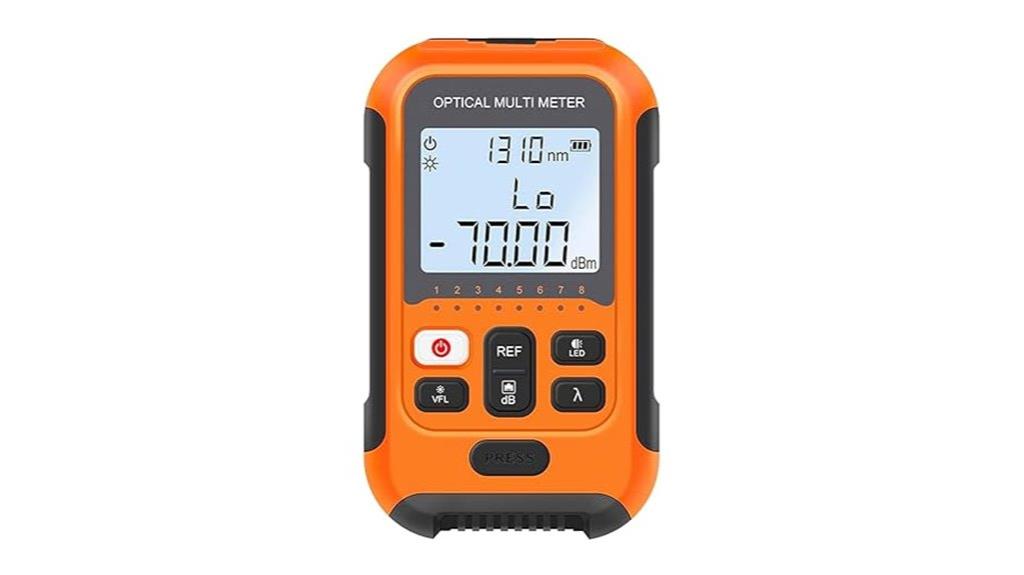
A fiber optic cable tester with a built-in fault locator and power meter is essential for professionals seeking quick, accurate diagnostics on the go. It combines an optical power meter and visual fault locator (VFL) in a compact, all-in-one device, supporting eight wavelengths from 850 to 1650 nm. This tester measures from -70 dBm to +6 dBm and features a 2 mW VFL for fault detection. It supports multiple interfaces like FC, SC, ST, and RJ45, displaying both mW and dBm readings simultaneously. Designed for versatility, it’s easy to calibrate, includes backlight functions, and is backed by lifetime customer support, ensuring precise, portable testing.
Best For: professional fiber optic technicians and network installers requiring a portable, all-in-one testing tool for diagnosing fiber optic cables quickly and accurately.
Pros:
- Combines optical power meter and visual fault locator in a compact, portable device for convenience.
- Supports multiple wavelengths (850/980/1300/1310/1490/1550/1625/1650 nm) and interfaces (FC, SC, ST, RJ45) for versatile testing.
- Features user-friendly functions like backlight, automatic shutdown, wavelength memory, and user calibration for enhanced usability and accuracy.
Cons:
- May require some training to fully utilize all advanced features and calibration options.
- Limited testing range from -70 dBm to +6 dBm, which may not suit all specialized fiber optic applications.
- As a portable device, long-term durability depends on proper handling and maintenance.
Factors to Consider When Choosing a DWDM Fiber Optic Multiplexer

When selecting a DWDM fiber optic multiplexer, I focus on key factors like wavelength compatibility and bandwidth capacity to guarantee it meets my network needs. Transmission distance and network integration are also essential for seamless performance and future expansion. Finally, I consider power requirements to maintain reliability and efficiency in my setup.
Wavelength Compatibility
Choosing a DWDM fiber optic multiplexer requires careful attention to wavelength compatibility, as supporting the right wavelengths is vital for peak network performance. I verify the device supports specific wavelengths needed for my network, typically ranging from 1470 nm to 1610 nm. It’s essential to verify that the multiplexer’s wavelength channels align with existing optical components and transceivers for seamless operation. I also consider whether the device offers flexible wavelength support or fixed channels, aligning with current and future wavelength plans. Additionally, I check the spectral width and channel spacing to prevent overlap and guarantee precise filtering. Finally, I select a multiplexer that adheres to industry standards, ensuring smooth integration and future upgradeability within my network infrastructure.
Bandwidth Capacity
Bandwidth capacity is a key factor that determines how much data a DWDM fiber optic multiplexer can handle at once. It’s primarily influenced by the number of channels the device supports simultaneously, which can range from 40 to over 200. Each channel typically transmits data at 10 Gbps or higher, substantially boosting total capacity. A higher bandwidth allows more data to flow through a single fiber, reducing the need for additional infrastructure. The spectral width and channel spacing also impact maximum throughput and overall capacity. Choosing a multiplexer with ample bandwidth is essential to meet current demands and future growth. Ensuring it can support increased data loads helps maintain network efficiency and scalability, vital for high-speed data transmission in evolving network environments.
Transmission Distance
The transmission distance of a DWDM fiber optic multiplexer plays a crucial role in ensuring data reaches its destination without significant signal loss. This distance varies widely, from around 80 km to over 1000 km, depending on the device and setup. Longer distances often require optical amplifiers or regenerators to preserve signal quality. The type of fiber used also impacts range; single-mode fibers support much longer spans than multi-mode fibers. Attenuation loss, influenced by wavelength and fiber quality, limits how far signals can travel before degradation. Environmental factors like fiber bending, splicing, and connector quality further affect effective transmission distance by increasing loss or causing faults. When selecting a multiplexer, I consider these factors carefully to match my network’s reach and reliability needs.
Network Integration
When integrating a DWDM fiber optic multiplexer into an existing network, guaranteeing compatibility with current infrastructure is vital for smooth operation. I check that the device supports standard protocols like Ethernet, SDH/SONET, or OTN to assure seamless data flow. Proper port configuration and wavelength planning are critical to prevent interference and maximize bandwidth utilization. I also verify that the multiplexer can interface with different fiber types, whether singlemode or multimode, to match my network’s cabling. Additionally, compatibility with management and monitoring systems such as SNMP or web interfaces simplifies network control and troubleshooting. By considering these factors, I ensure the multiplexer integrates smoothly, maintains network performance, and supports future scalability.
Power Requirements
Selecting the right DWDM fiber optic multiplexer requires careful attention to its power requirements to guarantee compatibility with your network’s infrastructure. First, confirm the device’s power supply matches your site’s voltage and frequency standards, whether 110V/220V AC or DC. Check if it needs an external power source or supports integrated options like Power over Ethernet (PoE). It’s essential to review the device’s power consumption in watts to verify your power infrastructure can support it without overloading circuits. Additionally, consider redundant power inputs or backup power options to enhance reliability during outages. Finally, verify that the multiplexer’s power specifications align with industry safety standards and local electrical codes for safe and compliant operation. Proper power planning ensures stable, efficient network performance.
Scalability Options
Considering the rapid growth of data traffic, ensuring your DWDM fiber optic multiplexer can scale with future demands is vital. I look for systems that allow wavelength channels to be expanded or upgraded, so I won’t have to replace the entire setup as bandwidth needs increase. Adding extra ports or modules is also essential, enabling my network to grow seamlessly. I check if the device supports flexible optical spectrum management for higher data rates or more channels over time. Channel spacing options matter too, as network standards evolve. Finally, I guarantee the multiplexer is compatible with my existing infrastructure, making expansion and integration straightforward. These scalability features help future-proof my network, saving costs and minimizing disruptions as my data needs grow.
Environmental Resilience
Environmental resilience is essential because a DWDM fiber optic multiplexer must withstand the conditions it’s deployed in, especially in outdoor or industrial settings. I look for devices with an IP65 rating or higher, ensuring resistance to dust and water ingress. Temperature tolerance is equally important; many models operate reliably from -40°C to +85°C, suitable for harsh environments. Rugged enclosures made from aluminum alloy or high-strength plastics provide protection against mechanical shocks and vibrations. To maintain signal quality, resistance to electromagnetic interference (EMI) and radio frequency interference (RFI) is essential, especially in high-electromagnetic areas. Proper thermal management, like integrated heat sinks or cooling fans, prevents overheating, ensuring consistent performance. These factors are critical for reliable, long-term operation in challenging environments.
Frequently Asked Questions
How Does Temperature Affect DWDM Multiplexer Performance?
Temperature critically influences DWDM multiplexer performance. When temperatures fluctuate, the equipment’s components can expand or contract, leading to signal loss or increased errors. I’ve observed that high temperatures can cause overheating, reducing efficiency and lifespan. Conversely, cold temperatures may cause condensation or connectivity issues. To guarantee ideal performance, I always recommend proper cooling and climate control in data centers, as stable temperatures help maintain signal integrity and device reliability.
What Are the Maintenance Requirements for High-Capacity DWDM Systems?
Maintaining high-capacity DWDM systems requires regular inspection and cleaning of fiber connectors to prevent signal loss. I also recommend monitoring system performance continuously and scheduling preventive maintenance to address potential issues early. Ensuring proper cooling is essential, especially in high-density setups. Additionally, updating firmware and software keeps the system secure and efficient. Staying proactive with these tasks guarantees peak performance and longevity of your DWDM infrastructure.
Can Existing Fiber Infrastructure Support 2025 DWDM Multiplexers?
If you’re wondering whether existing fiber infrastructure can support 2025 DWDM multiplexers, I’d say it depends. For example, I recently upgraded a network where the current fiber was installed over a decade ago. After testing, I found it could handle the higher bandwidth with some enhancements like dispersion compensation. So, in many cases, existing fiber can support upcoming multiplexers, but thorough testing and minor upgrades are essential for best performance.
What Security Features Are Integrated Into Modern DWDM Multiplexers?
Modern DWDM multiplexers come with advanced security features I find reassuring. They include encryption capabilities like AES, secure access controls, and physical security measures such as tamper-evident enclosures. Some also support remote monitoring with encrypted channels, ensuring data integrity and preventing unauthorized access. I believe these features are essential for safeguarding high-speed data networks against evolving cyber threats and maintaining reliable, secure communications.
How Do Future Bandwidth Demands Influence DWDM Component Selection?
Future bandwidth demands mean I need to select DWDM components that are scalable and support higher channel counts. I look for multiplexers with advanced modulation formats and flexible grid capabilities to accommodate growth. Upgrading should be seamless, so I prioritize equipment with future-proof features like software-defined configurations. This way, I guarantee my network stays ahead, efficiently handling increasing data loads without frequent hardware replacements.
Conclusion
As I wrap up my exploration of the best DWDM fiber optic multiplexers of 2025, I’m amazed at how far technology has come—it’s like having a teleportation device for data! Whether you’re setting up a high-speed network or ensuring seamless signal transmission, choosing the right multiplexer is key. Remember, in this digital age, staying ahead means embracing innovation—after all, who knows, maybe someday we’ll be transmitting data faster than the speed of light, just like in sci-fi!


